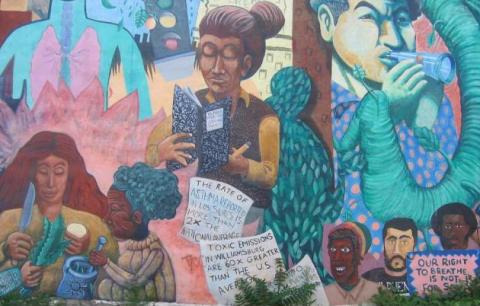Discussion:
"Legitimate theater" engages a paying audience sitting inside a theater with the expectation that they will watch the performance of a play or musical. These productions employ conventions normally associated with traditional theater: lights up and down, applause at the end of acts, a proscenium stage, professional actors working with prepared scripts, no significant interaction between performers and spectators.
Less than 2 percent of the population in the United States attends legitimate theater performances.
While legitimate theater has lost much of its relevance to our everyday lives, theater (or performance) in the broad sense is a fundamental human experience. As such it represents a reservoir of immense potential that a mediated experience can rarely provide: the potential for human interaction. Film and video provide a stream of images to watch, but no experiences in which the viewer can actually participate. Everyday life is often a sequence of ordinary, that is expected, events. One's life experiences easily become insulated from important world events — and the possibility of learning from new experiences as well. Ordinariness becomes a form of oppression and a steady dumbing down of society is deleterious to culture and to democracy as well. Performance provides an immediate human experience. Theater — particularly its "illegitimate" varieties — can also punctuate the ordinary and thrust new and unexpected experiences into everyday life. It has the power to bring a person into new, temporary realities in which the self is momentarily forgotten and submerged. Theater can empower the spectator with insight and possibilities.
Baz Kershaw in his insightful study of the British Alternative Theatre Movement over four decades explicitly addresses the role of theater as an instrument of "cultural intervention." His book (1992) "is about the ways in which theater practitioners have tried to change not just the future action of their audiences, but also the structure of the audience's community and the nature of the audience's culture." This pattern affirms Kershaw's observation: New theater should accompany a new society.
Other phrases — such as Theater Without Theater, Anti-Theater, Meta-Theater, The World's a Stage, Social Performance, Guerilla Theater, or Oppositional (or Radical or Provocative) Theater — are variations on the title of this pattern. Each of these alternative formulations focuses on some attributes and not on others. We use the term "Illegitimate Theater" primarily to highlight the differences between it and legitimate theater. Illegitimate theater can describe any performances in which one or more conventions of the legitimate theater are circumvented. For example, the convention of a single, discrete performance can be ignored in illegitimate theater. Thus, a "one-two punch" can be delivered, possibly anonymously: Half of the cast can "perform" — in Starbucks, at the zoo, or, even, a traditional theatrical venue — while the other half of the cast can "accidentally" encounter the audience afterwards and engage with them a second time, perhaps in dialogue, perhaps again as spectators, perhaps as actor / participants in a new performance that builds on ideas of the original one. The French group Le Grand Magic Circus devised a performance which gradually added the spectators (while withdrawing their members) at the "end" of their performance until finally the spectators were the only ones left "performing" (Bennett, 1990).
Performance is an extremely broad term that characterizes an infinite number of situations including sports, rituals, education, carnivals, politics and protest. It can encompass everyday social events such as shopping, eating in restaurants, going to parties or hanging out. Performance can be spontaneous or planned, obviously "staged" or masquerading as "real life," artistic, political, cultural. The advent of performance studies as an academic discipline which transcends the traditional notion of the theater has contributed to our understanding of these myriad forms.
Bertolt Brecht, the most influential artist/advocate of theater for social change, rejected Aristotelian drama (the basis of Legitimate Theater) in favor of the Epic or Dialectical Theater. His theories and plays, such as Three Penny Opera" and Mother Courage, blur the line between real life and performance, reveal the mechanics of production, present actor and character simultaneously, and employ a wide range of techniques designed to rouse the audience to social action. The venerable San Francisco Mime Troupe with performances such as Fact Wino vs. Armagoddonman, Damaged Care, and Mr. Smith Goes to Obscuristan, is a more recent incarnation of Brechtian rebellion. Augusto Boal from Brazil, a Workers' Party (PT) activist, pioneered "Theater of the Oppressed" and other forms of participatory role-playing theater that has helped audiences to explore and recognize their own predicaments while fostering cooperation and critical engagement.
Many public protests, especially those that include role playing, dramatic encounters, or masks, puppets and other props can be viewed as a type of performance. When Greenpeace's sailing ship "Rainbow Warrior" confronts a nuclear submarine or whaling ship, two symbolic worlds collide. Crosses symbolizing those killed in Iraq spring up in Crawford, Texas near the ranch of U.S. President George Bush; Argentine mothers and grandmothers clothed in mourning black stand before the president's Casa Rosa in Buenos Aires. More recently social activists employing techniques of illegitimate theater, have emerged to confront corporate globalization. These include the marching bands and giant puppets in the 1999 protests against the World Trade Organization in Seattle, Reverend Billy from the Church of Not Shopping who orchestrates chain store "interventions" to "unlock the hypnotic power of transnational capital" and the "Yes Men" who have "played the roles" (as they satirically interpreted them) of various corporate and organizational officials to unsuspecting audiences around the world.
As Clifford Geertz would say — and Shakespeare before him — the world is truly a stage and everything we do in public is a type of performance. This of course means in a trivial sense that everyday life provides a venue for exhibition and self-promotion. The media exploits people's desire for "fame" (or publicity — the desire to be made publicly recognizable) and exhibits the ones it considers off-beat enough for public display, in the modern day equivalent of a freak show.
Media is more easily commodified when it assumes rigid forms. When a "package" exists, it's relatively easy — and cost-effective — to replicate it again and again with little effort or creativity. And when commercial broadcast media defines what is "legitimate", the imagination of the people decays, their capacity to create is harder to draw upon, their tolerance for experimentation and "amateurism" diminishes. Illegitimate
Theater, like other patterns in this language, has unsavory manifestations as well: burning a cross in the yard of an African-American or other ethnic minority, militaristic parades and rallies, public intimidates. Since "performance" likely predates language, its effects on people can be deep; it can unlock hate as well as love, anger as well as reason and compassion. Theater, whether legitimate or not, can be driven by emotion and therefore less analytic than many other patterns in this language. Illegitimate
Theater blurs or even negates the line between spectators and performers. In its extreme version everybody, all the time, is an actor. And "actors" in public performances can also be "actors" in social life, actors who help make things happen — for good or for ill. Although our life "in public" is a series of performances, our roles are often construed as "bit parts." But every moment is a "teachable moment;" every public appearance is an opportunity to do something new and to experience something new. Thus anybody, at least in theory, can practice the craft of illegitimate theater. The "performances" that come from this practice can be simple or elaborate, impromptu or painstakingly rehearsed. The point is to cause ripples in the everyday stream of life.
Illegitimate theater, like is predecessors "legitimate" or otherwise, can be used to provoke emotional reactions, discussion or reflection. Practiced successfully and in a great number of venues, illegitimate theater could help foster positive social change and increased democratization of culture.








